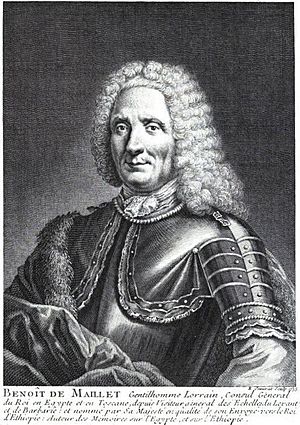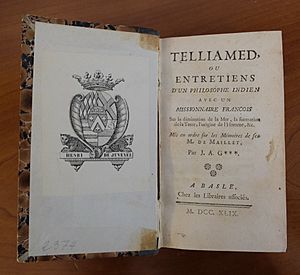Benoît de Maillet facts for kids
Benoît de Maillet (born in Saint-Mihiel on April 12, 1656 – died in Marseille on January 30, 1738) was a French diplomat and natural historian. He traveled a lot during his life. He served as the French consul general in Cairo. He also oversaw French interests in the Levant.
De Maillet developed a theory about how the Earth and its creatures came to be. He believed the Earth was not created instantly. Instead, he thought it developed slowly through natural processes. He also suggested that land animals originally came from sea creatures. He even thought humans might have started in the water. He estimated the Earth's development took about two billion years.
Contents
Benoît de Maillet's Life
Benoît de Maillet was a nobleman from Lorraine. He came from an important Catholic family. He didn't go to university. However, he received a very good education in classic subjects.
De Maillet was very interested in geology and natural history. He used his many travels to study the world around him. He was the French consul general in Cairo from 1692 to 1708. During this time, he studied the Egyptian pyramids. Later, he was consul in Leghorn from 1712 to 1717. He also oversaw French trade in the Levant and the Barbary states. He retired in 1715.
His Book: Telliamed
De Maillet's most famous book is called Telliamed. This is his last name, "Maillet," spelled backward. He wrote the ideas for this book between 1722 and 1732. However, it was only published after his death, in 1748.
The book was edited for ten years by a man named Abbot Jean Baptiste de Mascrier. Mascrier tried to make de Maillet's ideas fit with the teachings of the Catholic Church. Because of Mascrier's changes, none of the printed versions truly show de Maillet's original thoughts. The best version is the third edition, published in 1755. This edition also includes the only known story of de Maillet's life.
Historians have carefully compared the 1755 edition with de Maillet's original writings. They found that Mascrier added things and changed parts. Some of these changes even went against de Maillet's own ideas. Mascrier also reorganized parts of the book. He wanted it to be more like another popular book of the time.
In Telliamed, de Maillet shares his ideas through a character called an "Indian philosopher." This was a clever way for him to express his views. His ideas often went against the literal words of the Bible. At that time, sharing such ideas could be risky for a person's safety or job. The delay in publishing the book also helped protect both de Maillet and his editor. It gave the editor time to make the ideas seem less radical.
De Maillet's Theories
De Maillet's main theory was about the Earth's history. He believed the Earth was once completely covered by water. He called this an "ultraneptunian" theory. He based his ideas on what he saw during his travels. He observed sedimentary rocks and how they formed. He thought that sedimentation (layers of material settling) was the main way the Earth changed.
He noticed fossil shells in rocks high up on mountains. He realized these were once living sea creatures. He thought that the land had not risen. Instead, he believed the sea level had slowly dropped over time. He calculated that the sea level fell about three inches every century.
By working backward from the highest mountains, he estimated the Earth's age to be about 2.4 billion years. He thought it was reasonable that the Earth had been covered by water for at least 2 billion years. While his exact calculations were not perfect, his idea was groundbreaking. He understood that slow, natural processes could shape the Earth over incredibly long periods. He was one of the first to suggest the Earth was billions of years old. This idea was still debated even a century and a half after he died.
How Life Began
De Maillet also had interesting ideas about how life began. He thought life started in the water. This happened after the highest mountains appeared, but before the continents fully formed. He believed life first arose in the shallow waters around the new land.
Sea creatures like fish and shellfish grew and diversified. Their remains were covered by sediment. This formed new rocks on the sides of the early mountains. As continents rose from the water, marine organisms adapted. He suggested that seaweed developed into trees and shrubs. He even thought flying fish might have evolved into birds. He believed that humans also began as fish.
De Maillet thought that space contained tiny "seeds of life." He believed these invisible spores were always available to start new life. This idea about the origin of life is called panspermia. He also made an important observation about fossils. He noticed that older layers of sedimentary rocks contained different animals and plants than those alive today. Some types were completely unknown. He knew this was important, but his explanations for how these changes happened were not like our modern idea of evolution.
Human History Ideas
De Maillet's ideas about human history were not as strong. He included some myths and old traditions that were not correct. His method for calculating human history didn't work. This is because human remains are not found in the very old sedimentary rocks he studied.
He believed humans had a very long history. He thought they started in the water and then developed into land animals. He knew it was hard to explain why humans don't look like sea creatures anymore. His explanations for these problems were not very convincing. He tried to combine correct ideas about ancient tools (from the Iron Age and Bronze Age) with mistaken ideas. For example, he thought some old animal bones were human skeletons. He also thought petrified wood was fossilized ships.



